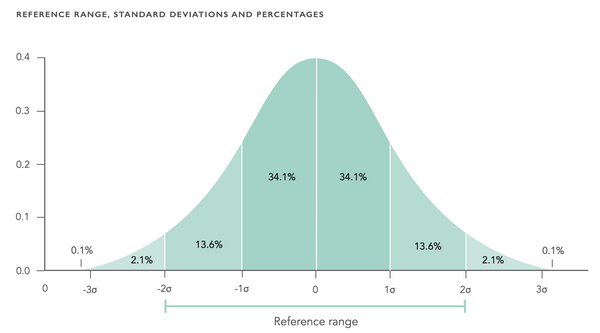Modern health care really means treating illnesses. Lab tests are generally used to find illness, not health. We wanted to create a comprehensive course based on preventive health care. It is therefore focused on preventing illness and promoting well-being.
Before offering you this simply unique online course, we want to share with you some important information that is also well covered in the course.
WHY “WITHIN REFERENCE RANGE” IS NOT ENOUGH AND MAY NOT MEAN A HEALTHY BODY?
Physicians generally consider findings “normal” if they fall within the reference range. Often they miss the big picture by ignoring various markers. A test result within the reference range is considered “normal”. However, there simply isn’t a clear-cut line between what is normal and what is not. This is why the term “reference range”, instead of “normal range”, is used.
To determine the reference range in each population group and for each laboratory marker, a significant set of healthy individuals is tested. The reference range is then mathematically calculated from these results so that the results of practically all healthy individuals fall within this range - the results of 95 % of healthy individuals fall within the reference range whilst approximately 5 % may have results that fall outside of it. The reasoning is that if 100 % of healthy individuals fell within the reference range, there would be too many so-called “false normal” results.
In practice, this means that an individual's tested value may fall near the upper or lower end, but still, within, the reference range, even if they have an illness.

WHAT IS AN OPTIMAL LEVEL?
Optimal values are likely to be based for example on findings made on a population level regarding low mortality or, for instance, the greatest likelihood of preventing cardiovascular disease associated with a particular marker.
Optimal levels, as opposed to a reference range, have also been defined for some vitamins. For example, a testosterone level at the lower end of the reference range may indicate subclinical hypogonadism.
However, it is crucial to always compare the results to your own previous results and track the changes over time, particularly after lifestyle changes. It is also beneficial to take several samples to get a bigger picture of various levels and to minimize the slight day-to-day variation before interpreting the results.

Optimize Your Lab Results Online Course in a nutshell:
- The systematic 6 part online course is created by Dr. Olli Sovijärvi, M.D.
- You will learn to understand and optimize your lab test results
- Every week, there is a comprehensive video made by Dr. Sovijärvi on each week's topic
- The online course includes downloadable, illustrated reading material and a platform where you can ask questions from a medical professional
- The online course also includes valuable additional materials gathered by Dr. Sovijärvi including articles, links, videos, and presentations
- You can begin the online course whenever you want – access to the materials also stays after the course
Take your place in the world’s first lab result optimization online course with Dr. Sovijärvi!





